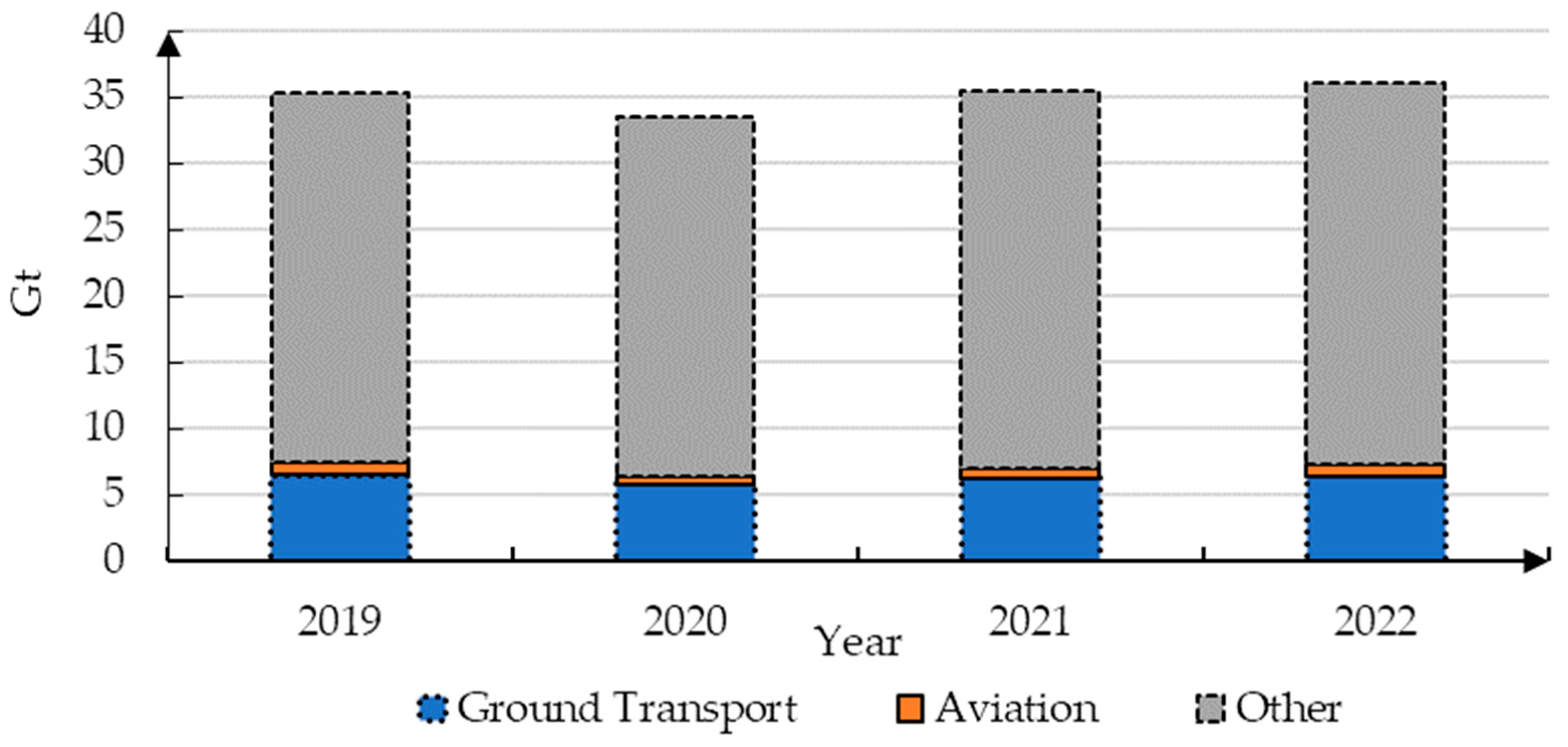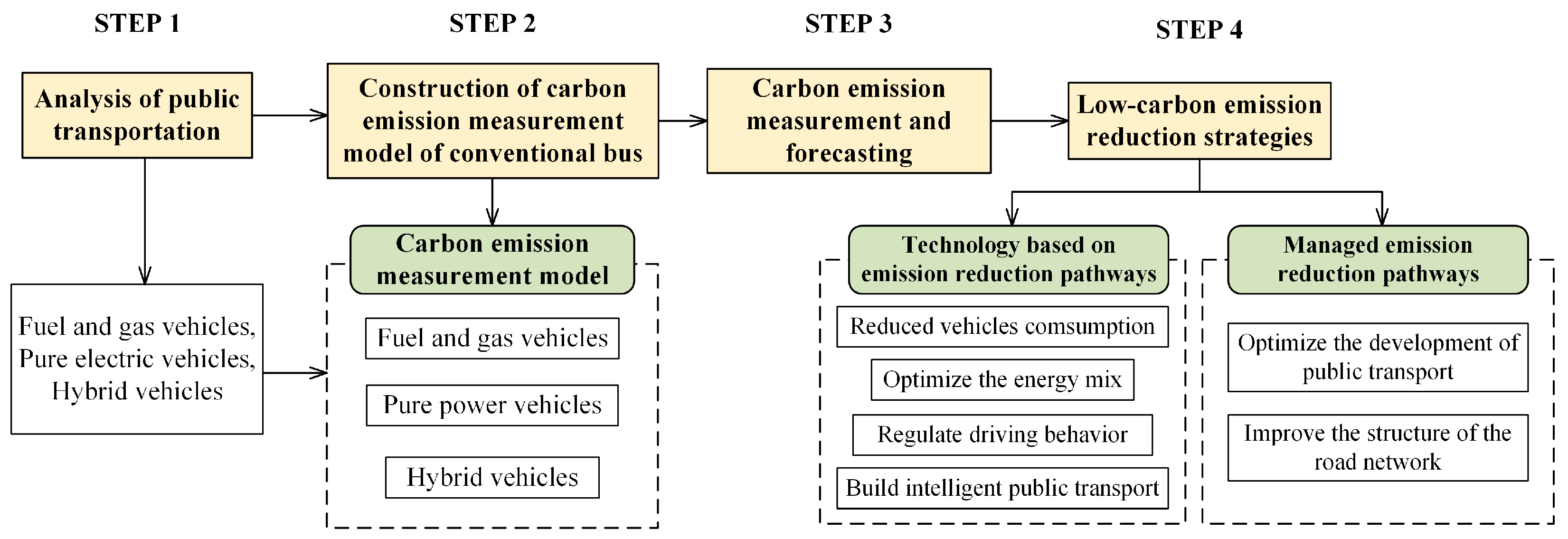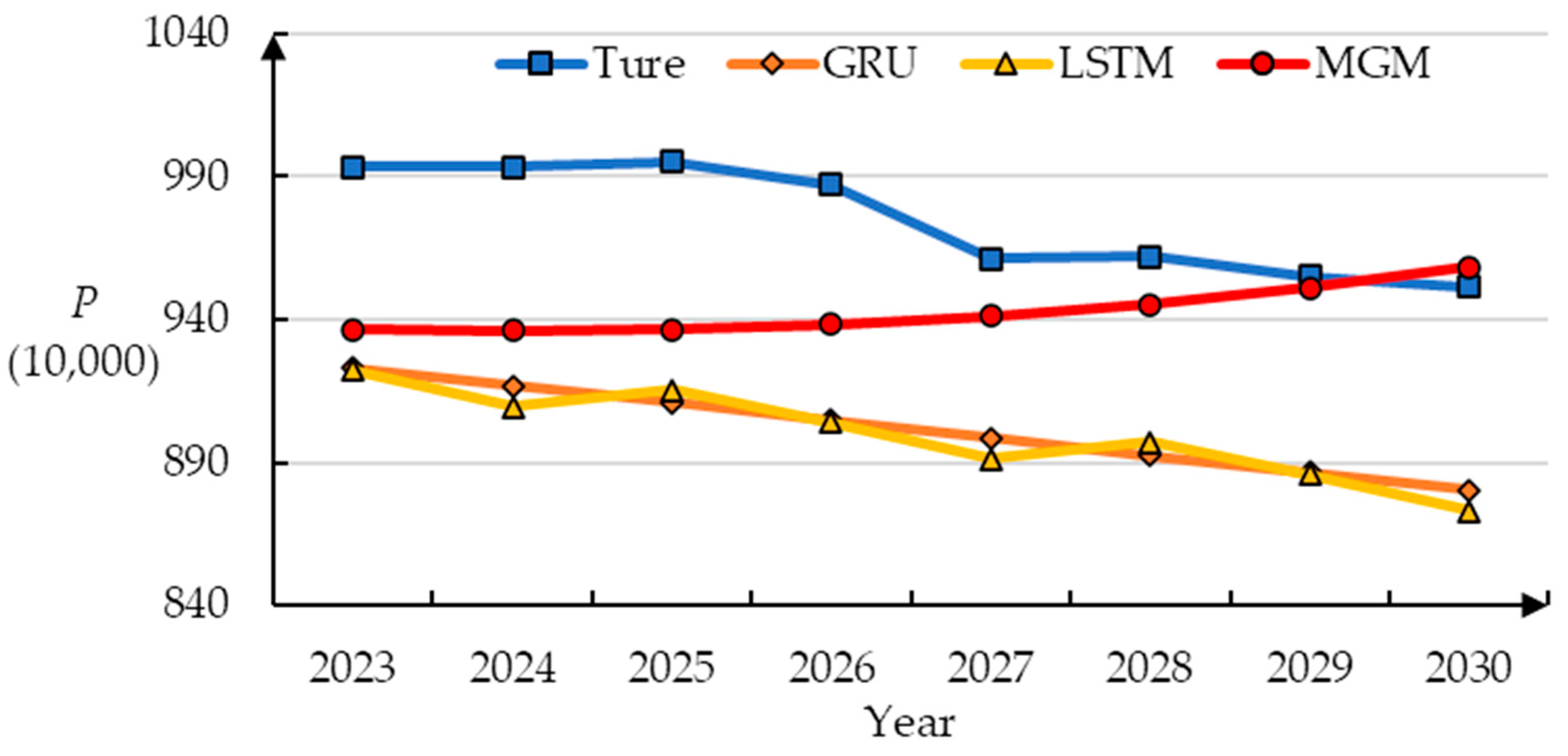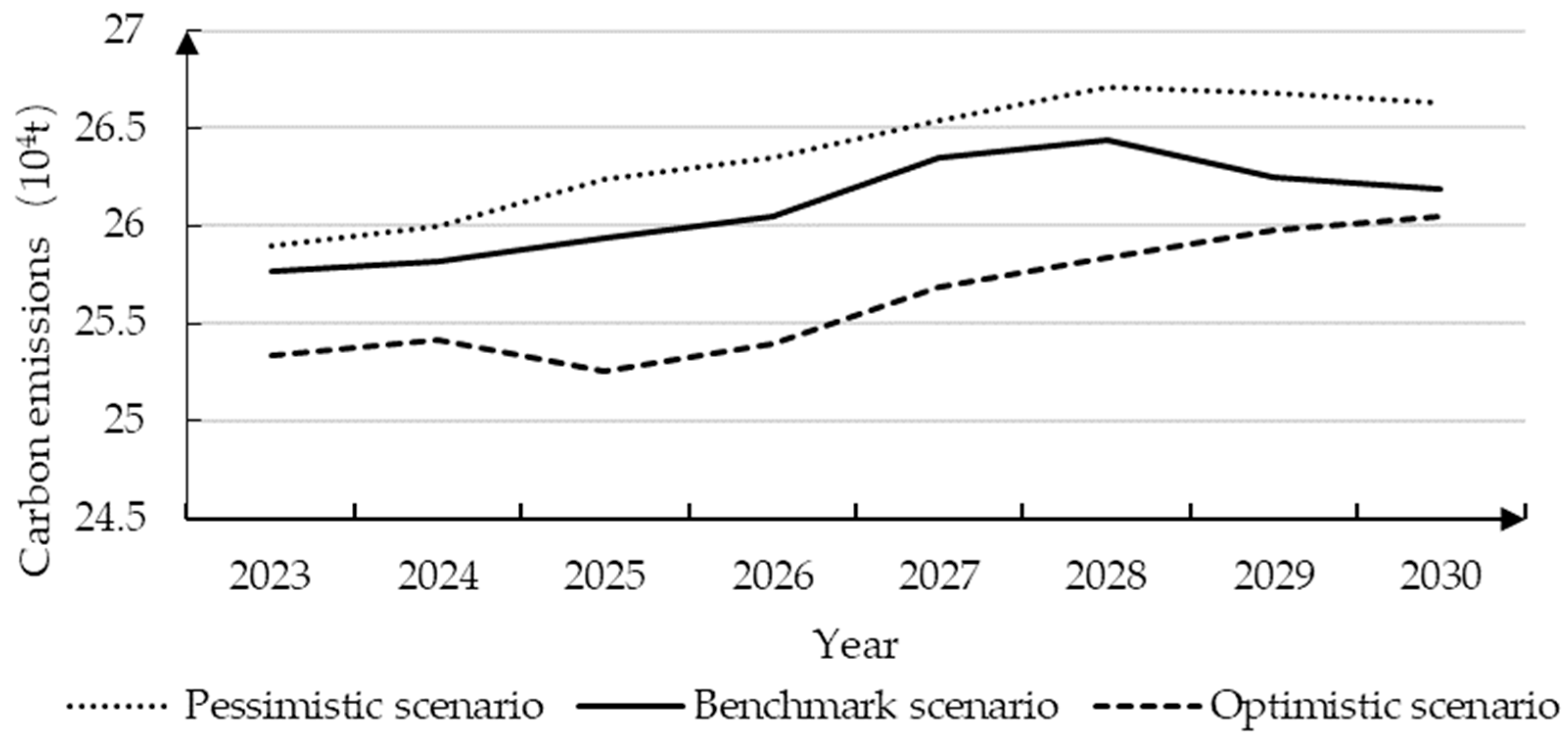Calculation of Carbon Emissions and Study of the Emission Reduction Path of Conventional Public Transportation in Harbin City
Abstract
:1. Introduction
2. Literature Review
2.1. Calculation of Carbon Emissions
2.2. Prediction of Carbon Emission
2.3. Emission Reduction Path
3. Methodology and Data Preparation
3.1. Emission Calculation Model
3.2. Emission Prediction
4. Case Study: Harbin, China
4.1. Emission Evaluation
4.2. Emission Prediction
4.2.1. Prediction Modeling and Baseline
4.2.2. Prediction Logic Explanation
4.2.3. Population Size Prediction
4.2.4. Prediction of Fuel Structure for Conventional Public Transportation in Harbin
- (1)
- Scenario analysis method
- (2)
- Scenario setting
- Pessimistic Scenario
- 2.
- Benchmark Scenario
- 3.
- Optimistic scenario
4.2.5. Carbon Emission Forecast of Conventional Public Transportation in Harbin
5. Discussion
6. Conclusions
- By constructing an MGM, an indicator system was constructed based on three aspects, natural population growth rate, population structure, and economic level, to predict the population size of Harbin. According to the predictions, the population of Harbin will reach 9.5824 million in 2030.
- A scenario analysis method was used to analyze the fuel structure of buses in Harbin from three perspectives: a pessimistic scenario, a baseline scenario, and an optimistic scenario. By 2030, the proportion of pure electric buses in the three scenarios will be 75%, 85%, and 92%, respectively.
- This article calculates the carbon emissions of regular buses in Harbin from 2023 to 2030. The carbon emissions under the three scenarios (pessimistic, baseline, and optimistic) in 2030 are 266,310.84 tons, 261,947.71 tons, and 260,562.21 tons, respectively.
Author Contributions
Funding
Institutional Review Board Statement
Informed Consent Statement
Data Availability Statement
Conflicts of Interest
References
- Bashmakov, I.A.; Nilsson, L.J.; Acquaye, A.; Bataille, C.; Cullen, J.M.; de la Rue du Can, S.; Fischedick, M.; Geng, Y.; Tanaka, K. Climate Change 2022: Mitigation of Climate Change. Contribution of Working Group III to the Sixth Assessment Report of the Intergovernmental Panel on Climate Change; Cambridge University Press: Cambridge, UK; New York, NY, USA, 2022. [Google Scholar] [CrossRef]
- Brand, C.; Goodman, A.; Rutter, H.; Song, Y.; Ogilvie, D. Associations of Individual, Household and Environmental Characteristics with Carbon Dioxide Emissions from Motorised Passenger Travel. Appl. Energy 2013, 104, 158–169. [Google Scholar] [CrossRef] [PubMed]
- Fan, J.-L.; Wang, J.-X.; Li, F.; Yu, H.; Zhang, X. Energy Demand and Greenhouse Gas Emissions of Urban Passenger Transport in the Internet Era: A Case Study of Beijing. J. Clean. Prod. 2017, 165, 177–189. [Google Scholar] [CrossRef]
- Jelti, F.; Allouhi, A.; Al-Ghamdi, S.G.; Saadani, R.; Jamil, A.; Rahmoune, M. Environmental Life Cycle Assessment of Alternative Fuels for City Buses: A Case Study in Oujda City, Morocco. Int. J. Hydrogen Energy 2021, 46, 25308–25319. [Google Scholar] [CrossRef]
- Luo, Y.; Liu, S.; Che, L.; Yu, Y. Analysis of Temporal Spatial Distribution Characteristics of PM2.5 Pollution and the Influential Meteorological Factors Using Big Data in Harbin, China. J. Air Waste Manag. Assoc. 2021, 71, 964–973. [Google Scholar] [CrossRef] [PubMed]
- Xu, H.; Pei, Y.; Wang, L.; Zhang, W. Emission Reduction of CO2 Caused by BEV in Urban Passenger Transport: A Case Study of Harbin. J. Transp. Inf. Saf. 2018, 36, 111–118. [Google Scholar]
- Wen, L.; Wang, A. System Dynamics Model of Beijing Urban Public Transport Carbon Emissions Based on Carbon Neutrality Target. Environ. Dev. Sustain. 2022, 25, 12681–12706. [Google Scholar] [CrossRef]
- Dong, D.; Duan, H.; Mao, R.; Song, Q.; Zuo, J.; Zhu, J.; Wang, G.; Hu, M.; Dong, B.; Liu, G. Towards a Low Carbon Transition of Urban Public Transport in Megacities: A Case Study of Shenzhen, China. Resour. Conserv. Recycl. 2018, 134, 149–155. [Google Scholar] [CrossRef]
- Zhang, S.; Wu, Y.; Liu, H.; Huang, R.; Yang, L.; Li, Z.; Fu, L.; Hao, J. Real-World Fuel Consumption and CO2 Emissions of Urban Public Buses in Beijing. Appl. Energy 2014, 113, 1645–1655. [Google Scholar] [CrossRef]
- Shan, Y.; Guan, D.; Liu, J.; Mi, Z.; Liu, Z.; Liu, J.; Schroeder, H.; Cai, B.; Chen, Y.; Shao, S.; et al. Methodology and Applications of City Level CO2 Emission Accounts in China. J. Clean. Prod. 2017, 161, 1215–1225. [Google Scholar] [CrossRef]
- Alam, M.S.; Duffy, P.; Hyde, B.; McNabola, A. Improvement in the Estimation and Back-Extrapolation of CO2 Emissions from the Irish Road Transport Sector Using a Bottom-up Data Modelling Approach. Transp. Res. Part D Transp. Environ. 2017, 56, 18–32. [Google Scholar] [CrossRef]
- Ghaemi, Z.; Smith, A.D. A Review on the Quantification of Life Cycle Greenhouse Gas Emissions at Urban Scale. J. Clean. Prod. 2020, 252, 119634. [Google Scholar] [CrossRef]
- Milovanoff, A.; Minet, L.; Cheah, L.; Posen, I.D.; MacLean, H.L.; Balasubramanian, R. Greenhouse Gas Emission Mitigation Pathways for Urban Passenger Land Transport under Ambitious Climate Targets. Environ. Sci. Technol. 2021, 55, 8236–8246. [Google Scholar] [CrossRef]
- Zhang, L.; Long, R.; Chen, H.; Geng, J. A Review of China’s Road Traffic Carbon Emissions. J. Clean. Prod. 2019, 207, 569–581. [Google Scholar] [CrossRef]
- Ding, S.; Dang, Y.-G.; Li, X.-M.; Wang, J.-J.; Zhao, K. Forecasting Chinese CO2 Emissions from Fuel Combustion Using a Novel Grey Multivariable Model. J. Clean. Prod. 2017, 162, 1527–1538. [Google Scholar] [CrossRef]
- Ding, S.; Xu, N.; Ye, J.; Zhou, W.; Zhang, X. Estimating Chinese Energy-Related CO2 Emissions by Employing a Novel Discrete Grey Prediction Model. J. Clean. Prod. 2020, 259, 120793. [Google Scholar] [CrossRef]
- He, Z.; Zhang, W.; Jia, N. Estimating Carbon Dioxide Emissions of Freeway Traffic: A Spatiotemporal Cell-Based Model. IEEE Trans. Intell. Transp. Syst. 2020, 21, 1976–1986. [Google Scholar] [CrossRef]
- Pan, Y.; Qiao, F.; Tang, K.; Chen, S.; Ukkusuri, S.V. Understanding and Estimating the Carbon Dioxide Emissions for Urban Buses at Different Road Locations: A Comparison between New-Energy Buses and Conventional Diesel Buses. Sci. Total Environ. 2020, 703, 135533. [Google Scholar] [CrossRef]
- Mądziel, M. Liquified Petroleum Gas-Fuelled Vehicle CO2 Emission Modelling Based on Portable Emission Measurement System, On-Board Diagnostics Data, and Gradient-Boosting Machine Learning. Energies 2023, 16, 2754. [Google Scholar] [CrossRef]
- Jaworski, A.; Mądziel, M.; Kuszewski, H. Sustainable Public Transport Strategies—Decomposition of the Bus Fleet and Its Influence on the Decrease in Greenhouse Gas Emissions. Energies 2022, 15, 2238. [Google Scholar] [CrossRef]
- Azam, M.; Othman, J.; Begum, R.A.; Abdullah, S.M.S.; Nor, N.G.M. Energy Consumption and Emission Projection for the Road Transport Sector in Malaysia: An Application of the LEAP Model. Environ. Dev. Sustain. 2016, 18, 1027–1047. [Google Scholar] [CrossRef]
- Alfaseeh, L.; Tu, R.; Farooq, B.; Hatzopoulou, M. Greenhouse Gas Emission Prediction on Road Network Using Deep Sequence Learning. Transp. Res. Part D Transp. Environ. 2020, 88, 102593. [Google Scholar] [CrossRef]
- Gao, M.; Yang, H.; Xiao, Q.; Goh, M. A Novel Fractional Grey Riccati Model for Carbon Emission Prediction. J. Clean. Prod. 2021, 282, 124471. [Google Scholar] [CrossRef]
- Özceylan, E. Forecasting CO2 Emission of Turkey: Swarm Intelligence Approaches. Int. J. Glob. Warm. 2016, 9, 337–361. [Google Scholar] [CrossRef]
- Fang, D.; Zhang, X.; Yu, Q.; Jin, T.C.; Tian, L. A Novel Method for Carbon Dioxide Emission Forecasting Based on Improved Gaussian Processes Regression. J. Clean. Prod. 2018, 173, 143–150. [Google Scholar] [CrossRef]
- Aggarwal, P.; Jain, S. Energy Demand and CO2 Emissions from Urban On-Road Transport in Delhi: Current and Future Projections under Various Policy Measures. J. Clean. Prod. 2016, 128, 48–61. [Google Scholar] [CrossRef]
- Li, W.; Li, H.; Zhang, H.; Sun, S. The Analysis of CO2 Emissions and Reduction Potential in China’s Transport Sector. Math. Probl. Eng. 2016, 2016, e1043717. [Google Scholar] [CrossRef]
- Kousoulidou, M.; Ntziachristos, L.; Mellios, G.; Samaras, Z. Road-Transport Emission Projections to 2020 in European Urban Environments. Atmos. Environ. 2008, 42, 7465–7475. [Google Scholar] [CrossRef]
- Liu, J.; Zhang, X.; Song, X. Regional Carbon Emission Evolution Mechanism and Its Prediction Approach Driven by Carbon Trading–A Case Study of Beijing. J. Clean. Prod. 2018, 172, 2793–2810. [Google Scholar] [CrossRef]
- Grácio, M.; Finet, C.; Desaeger, M.; Da Silva, F.N.; Coelho, M. Prospects for Energy Usage and Carbon Dioxide That Affect European Transportation Sector. Transp. Res. Rec. 2012, 2287, 54–63. [Google Scholar] [CrossRef]
- Pamuła, T.; Pamuła, D. Prediction of Electric Buses Energy Consumption from Trip Parameters Using Deep Learning. Energies 2022, 15, 1747. [Google Scholar] [CrossRef]
- Jovanovic, M. Belgrade’s Urban Transport CO2 Emissions from an International Perspective. Pol. J. Environ. Stud. 2016, 25, 635–646. [Google Scholar] [CrossRef]
- Arioli, M.; Fulton, L.; Lah, O. Transportation Strategies for a 1.5 °C World: A Comparison of Four Countries. Transp. Res. Part D Transp. Environ. 2020, 87, 102526. [Google Scholar] [CrossRef]
- Chatziioannou, I.; Alvarez-Icaza, L.; Bakogiannis, E.; Kyriakidis, C.; Chias-Becerril, L. A Structural Analysis for the Categorization of the Negative Externalities of Transport and the Hierarchical Organization of Sustainable Mobility’s Strategies. Sustainability 2020, 12, 6011. [Google Scholar] [CrossRef]
- Liu, Y.; Wang, Y.; Lyu, P.; Hu, S.; Yang, L.; Gao, G. Rethinking the Carbon Dioxide Emissions of Road Sector: Integrating Advanced Vehicle Technologies and Construction Supply Chains Mitigation Options under Decarbonization Plans. J. Clean. Prod. 2021, 321, 128769. [Google Scholar] [CrossRef]
- Wu, Y.; Zhang, S.; Hao, J.; Liu, H.; Wu, X.; Hu, J.; Walsh, M.P.; Wallington, T.J.; Zhang, K.M.; Stevanovic, S. On-Road Vehicle Emissions and Their Control in China: A Review and Outlook. Sci. Total Environ. 2017, 574, 332–349. [Google Scholar] [CrossRef]
- Jung, J.; Koo, Y. Analyzing the Effects of Car Sharing Services on the Reduction of Greenhouse Gas (GHG) Emissions. Sustainability 2018, 10, 539. [Google Scholar] [CrossRef]
- Fan, F.; Lei, Y. Decomposition Analysis of Energy-Related Carbon Emissions from the Transportation Sector in Beijing. Transp. Res. Part D Transp. Environ. 2016, 42, 135–145. [Google Scholar] [CrossRef]
- Altieri, K.E.; Trollip, H.; Caetano, T.; Hughes, A.; Merven, B.; Winkler, H. Achieving Development and Mitigation Objectives through a Decarbonization Development Pathway in South Africa. Clim. Policy 2016, 16, S78–S91. [Google Scholar] [CrossRef]
- Bayer, P.; Aklin, M. The European Union Emissions Trading System Reduced CO2 Emissions despite Low Prices. Proc. Natl. Acad. Sci. USA 2020, 117, 8804–8812. [Google Scholar] [CrossRef] [PubMed]
- Cao, J.; Ho, M.S.; Jorgenson, D.W.; Nielsen, C.P. China’s Emissions Trading System and an ETS-Carbon Tax Hybrid. Energy Econ. 2019, 81, 741–753. [Google Scholar] [CrossRef]
- Gitarskiy, M.L. The Refinement to the 2006 IPCC Guidelines for National Greenhouse Gas Inventories. Fundam. Appl. Climatol. 2019, 2, 5–13. [Google Scholar] [CrossRef]
- GB 30510-2018; China Automotive Technology and Research Center. Fuel Consumption Limits for Heavy-Duty Commercial Vehicles. General Administration of Quality Supervision, Inspection and Quarantine of the People’s Republic of China, China National Standardization Administration Committee: Beijing, China, 2018; p. 12.
- Huang, Y.; Guo, H.; Xie, P.; Liao, C.; Zhao, D. Study on Carbon Emission Reduction Calculation of Subway Travel—Take Guangzhou as an Example. Clim. Chang. Res. 2017, 13, 284. [Google Scholar] [CrossRef]
- Qin, B.; Li, C. Shanghai New Energy Transportation and Air Pollution Control from the Perspective of Input Cost—Emission Reduction Benefit. Technol. Innov. Manag. 2018, 39, 409–414. [Google Scholar] [CrossRef]
- Mai, W.; Zou, L.; Wang, Y.; Feng, Z. Analysis to the potential of energy-saving and emission-reduction of urban passenger transport: A case study of Zhenjiang City. Urban Probl. 2017, 08, 31–41. [Google Scholar] [CrossRef]
- Guo, H.; Huang, Y.; Liao, C.; Zhao, D. Methodology Study on Carbon Emission Reduction Calculation of Bus Travel: Taking Guangzhou as an Example. Ecol. Econ. 2019, 35, 44–48. [Google Scholar]
- Wang, X.; Gao, X. The Spatial Distribution and Evolution Characteristics of the Muslim Population in China. World Reg. Stud. 2021, 30, 1297. [Google Scholar] [CrossRef]
- Gao, H.; Yao, T.; Kang, X. Population Forecast of Anhui Province Based on the GM(1,1) Model. Grey Syst. Theory Appl. 2017, 7, 19–30. [Google Scholar] [CrossRef]
- Liu, S.; Zhao, M.; Bao, C.; Liu, J. Carbon Emission Calculation for Urban Transport Based on Scenario Analysis of Traffic Structure. J. Transp. Syst. Eng. Inf. Technol. 2015, 15, 222. [Google Scholar]
- GB/T 51328-2018; Standard for Urban Comprehensive Transport System Planning. Ministry of Housing and Urban-Rural Development of the People’s Republic of China, China Urban Planning and Design Institute: Beijing, China, 2018.
- Bristow, A.L.; Tight, M.; Pridmore, A.; May, A.D. Developing pathways to low carbon land-based passenger transport in Great Britain by 2050. Energy Policy 2008, 36, 3427–3435. [Google Scholar] [CrossRef]




| Vehicle Type | Quantity (Vehicles) | Energy | Energy Consumption of 100 km per Vehicle | Carbon Emission Factor |
|---|---|---|---|---|
| Gasoline vehicle | 48 | Petrol | 37.2 L ① | 2.25 kg/L |
| Diesel vehicle | 1209 | Diesel oil | 31 L ② | 2.64 kg/L |
| Natural gas vehicle | 1022 | Natural gas | 35 m3 ③ | 2.19 kg/m3 |
| Pure electric vehicle | 4856 | Electric energy | 90 kWh ④ | - |
| Hybrid vehicle | 1296 | Electric energy Natural gas | 3.9 kWh ⑤ 27.2 m 3⑥ | - 2.19 kg/m3 |
| Vehicle Type | Energy | Carbon Emissions per Bike (kg) | Total Carbon Emissions (kg) |
|---|---|---|---|
| Gasoline vehicle | Petrol | 38,083.50 | 1,828,008 |
| Diesel vehicle | Diesel oil | 37,237.20 | 45,019,775 |
| Natural gas vehicle | Natural gas | 34,875.75 | 35,643,017 |
| Pure electric vehicle | Electric energy | 28,045.18 | 136,187,398 |
| Hybrid vehicle | Electric energy Natural gas | 28,318.73 | 36,701,076 |
| Indicator | Level 1 Index | Level 2 Index |
|---|---|---|
| Population P (10,000) | Natural population growth rate | Birth rate X1(‰) |
| Mortality rate X2(‰) | ||
| Population structure | Proportion of labor force X3(%) | |
| Urban population X4(10,000) | ||
| Economic level | Per capita GDP X5(Yuan per person) | |
| Average wages of on-duty workers X6(Yuan per person) | ||
| Average wages of on-duty workers and consumer price index X7(CPI) |
| Year | P | X1 | X2 | X3 | X4 | X5 | X6 | X7 |
|---|---|---|---|---|---|---|---|---|
| 2011 | 993.27 | 8.3 | 5.6 | 70.73 | 476.45 | 27,380 | 36,450 | 105.6 |
| 2012 | 993.51 | 8.7 | 9.2 | 70.33 | 478.93 | 29,973 | 41,773 | 103.2 |
| 2013 | 995.20 | 8.3 | 5.5 | 69.42 | 480.80 | 33,299 | 47,150 | 102.1 |
| 2014 | 987.29 | 8.6 | 8.2 | 68.29 | 481.30 | 35,741 | 51,554 | 102.0 |
| 2015 | 961.37 | 6.2 | 6.4 | 67.10 | 464.34 | 38,858 | 58,405 | 101.4 |
| 2016 | 962.05 | 7.0 | 4.7 | 66.10 | 467.75 | 42,425 | 62,583 | 101.8 |
| 2017 | 954.99 | 7.7 | 16.4 | 65.60 | 463.81 | 45,974 | 67,542 | 101.6 |
| 2018 | 951.54 | 6.1 | 5.7 | 64.66 | 467.54 | 49,097 | 71,771 | 102.6 |
| 2019 | 951.34 | 5.6 | 5.1 | 63.92 | 473.92 | 50,650 | 82,385 | 101.4 |
| 2020 | 948.55 | 4.8 | 6.1 | 62.80 | 528.44 | 51,113 | 84,796 | 100.6 |
| Year | P | X1 | X2 | X3 | X4 | X5 | X6 | X7 |
|---|---|---|---|---|---|---|---|---|
| 2023 | 936.59 | 3.9 | 6.5 | 60.26 | 496.69 | 65,753 | 112,562 | 100.6 |
| 2024 | 936.07 | 3.4 | 6.3 | 59.43 | 499.35 | 70,265 | 122,692 | 100.4 |
| 2025 | 936.61 | 3.0 | 6.2 | 58.61 | 502.02 | 75,087 | 133,736 | 100.2 |
| 2026 | 938.30 | 2.6 | 6.1 | 57.80 | 504.71 | 80,239 | 145,772 | 100.0 |
| 2027 | 941.22 | 2.1 | 5.9 | 57.00 | 507.41 | 85,745 | 158,892 | 99.8 |
| 2028 | 945.45 | 1.7 | 5.8 | 56.22 | 510.12 | 91,629 | 173,192 | 99.7 |
| 2029 | 951.09 | 1.3 | 5.6 | 55.44 | 512.85 | 97,917 | 188,780 | 99.5 |
| 2030 | 958.24 | 0.8 | 5.5 | 54.67 | 515.59 | 104,636 | 205,771 | 99.3 |
| Year | P | X1 | X2 | X3 | X4 | X5 | X6 | X7 |
|---|---|---|---|---|---|---|---|---|
| 2023 | 922.42 | 4.04 | 6.6 | 60.11 | 534.21 | 52,875 | 101,477 | 99.6 |
| 2024 | 909.68 | 3.64 | 6.2 | 59.21 | 536.14 | 53,462 | 106,895 | 99.3 |
| 2025 | 915.44 | 3.24 | 6.5 | 58.30 | 538.06 | 54,048 | 112,313 | 98.9 |
| 2026 | 904.16 | 2.85 | 6.2 | 57.40 | 539.98 | 54,635 | 117,731 | 98.6 |
| 2027 | 891.41 | 2.45 | 6.1 | 56.50 | 541.91 | 55,221 | 123,149 | 98.3 |
| 2028 | 897.17 | 2.05 | 5.9 | 55.59 | 543.83 | 55,808 | 128,567 | 97.9 |
| 2029 | 885.89 | 1.65 | 6.0 | 54.69 | 545.76 | 56,395 | 133,985 | 97.6 |
| 2030 | 873.14 | 1.25 | 6.2 | 53.79 | 547.68 | 56,981 | 139,404 | 97.2 |
| Year | P | X1 | X2 | X3 | X4 | X5 | X6 | X7 |
|---|---|---|---|---|---|---|---|---|
| 2023 | 923.06 | 3.57 | 6.6 | 60.04 | 530.08 | 53,316 | 91,052 | 100.3 |
| 2024 | 916.95 | 3.60 | 6.3 | 59.20 | 535.68 | 53,880 | 95,312 | 99.6 |
| 2025 | 910.84 | 2.72 | 6.5 | 58.48 | 533.70 | 54,699 | 101,950 | 99.2 |
| 2026 | 904.73 | 2.76 | 6.7 | 57.34 | 539.30 | 55,263 | 106,209 | 99.0 |
| 2027 | 898.63 | 1.88 | 6.3 | 56.51 | 537.32 | 56,082 | 112,847 | 98.2 |
| 2028 | 892.52 | 1.92 | 6.5 | 55.79 | 542.92 | 56,645 | 117,106 | 97.9 |
| 2029 | 886.41 | 1.04 | 6.6 | 54.65 | 540.94 | 57,465 | 123,744 | 97.6 |
| 2030 | 880.30 | 1.08 | 5.2 | 53.82 | 546.54 | 58,028 | 128,003 | 97.3 |
| Model | RMSE | MAE | MAPE (%) |
|---|---|---|---|
| MGM | 17.92 | 23.52 | 5.71 |
| LSTM | 24.21 | 64.13 | 7.71 |
| GRU | 25.22 | 62.36 | 8.48 |
| Year | Gasoline (%) | Diesel (%) | Natural Gas (%) | Pure Electric (%) | Hybrid (%) |
|---|---|---|---|---|---|
| 2023 | 0 | 12 | 12 | 58 | 18 |
| 2024 | 0 | 12 | 10 | 58 | 20 |
| 2025 | 0 | 12 | 10 | 58 | 20 |
| 2026 | 0 | 10 | 10 | 62 | 18 |
| 2027 | 0 | 10 | 8 | 64 | 18 |
| 2028 | 0 | 8 | 8 | 69 | 15 |
| 2029 | 0 | 8 | 5 | 72 | 15 |
| 2030 | 0 | 5 | 5 | 75 | 15 |
| Year | Gasoline (%) | Diesel (%) | Natural Gas (%) | Pure Electric (%) | Hybrid (%) |
|---|---|---|---|---|---|
| 2023 | 0 | 12 | 10 | 63 | 15 |
| 2024 | 0 | 10 | 10 | 67 | 13 |
| 2025 | 0 | 10 | 8 | 69 | 13 |
| 2026 | 0 | 8 | 8 | 71 | 13 |
| 2027 | 0 | 8 | 8 | 74 | 10 |
| 2028 | 0 | 5 | 8 | 77 | 10 |
| 2029 | 0 | 3 | 5 | 82 | 10 |
| 2030 | 0 | 0 | 5 | 85 | 10 |
| Year | Gasoline (%) | Diesel (%) | Natural Gas (%) | Pure Electric (%) | Hybrid (%) |
|---|---|---|---|---|---|
| 2023 | 0 | 5 | 12 | 68 | 15 |
| 2024 | 0 | 5 | 10 | 72 | 13 |
| 2025 | 0 | 0 | 10 | 77 | 13 |
| 2026 | 0 | 0 | 8 | 79 | 13 |
| 2027 | 0 | 0 | 8 | 82 | 10 |
| 2028 | 0 | 0 | 5 | 85 | 10 |
| 2029 | 0 | 0 | 5 | 90 | 5 |
| 2030 | 0 | 0 | 3 | 92 | 5 |
| Year | Pessimistic Scenario | Benchmark Scenario | Optimistic Scenario |
|---|---|---|---|
| 2023 | 259,013.31 | 257,763.70 | 253,390.34 |
| 2024 | 260,019.42 | 258,253.33 | 254,254.63 |
| 2025 | 262,451.60 | 259,469.31 | 252,596.79 |
| 2026 | 263,531.50 | 260,566.40 | 254,040.73 |
| 2027 | 265,403.95 | 263,556.86 | 256,954.44 |
| 2028 | 267,128.48 | 264,495.78 | 258,451.40 |
| 2029 | 266,846.99 | 262,516.42 | 259,868.01 |
| 2030 | 266,310.84 | 261,947.71 | 260,562.21 |
Disclaimer/Publisher’s Note: The statements, opinions and data contained in all publications are solely those of the individual author(s) and contributor(s) and not of MDPI and/or the editor(s). MDPI and/or the editor(s) disclaim responsibility for any injury to people or property resulting from any ideas, methods, instructions or products referred to in the content. |
© 2023 by the authors. Licensee MDPI, Basel, Switzerland. This article is an open access article distributed under the terms and conditions of the Creative Commons Attribution (CC BY) license (https://creativecommons.org/licenses/by/4.0/).
Share and Cite
Zhang, W.; Zhou, G.; Song, Z.; Shi, X.; Ye, M.; Chen, X.; Xiang, Y.; Zheng, W.; Zhang, P. Calculation of Carbon Emissions and Study of the Emission Reduction Path of Conventional Public Transportation in Harbin City. Sustainability 2023, 15, 16025. https://doi.org/10.3390/su152216025
Zhang W, Zhou G, Song Z, Shi X, Ye M, Chen X, Xiang Y, Zheng W, Zhang P. Calculation of Carbon Emissions and Study of the Emission Reduction Path of Conventional Public Transportation in Harbin City. Sustainability. 2023; 15(22):16025. https://doi.org/10.3390/su152216025
Chicago/Turabian StyleZhang, Wenhui, Ge Zhou, Ziwen Song, Xintao Shi, Meiru Ye, Xirui Chen, Yuhao Xiang, Wenzhao Zheng, and Pan Zhang. 2023. "Calculation of Carbon Emissions and Study of the Emission Reduction Path of Conventional Public Transportation in Harbin City" Sustainability 15, no. 22: 16025. https://doi.org/10.3390/su152216025
APA StyleZhang, W., Zhou, G., Song, Z., Shi, X., Ye, M., Chen, X., Xiang, Y., Zheng, W., & Zhang, P. (2023). Calculation of Carbon Emissions and Study of the Emission Reduction Path of Conventional Public Transportation in Harbin City. Sustainability, 15(22), 16025. https://doi.org/10.3390/su152216025









